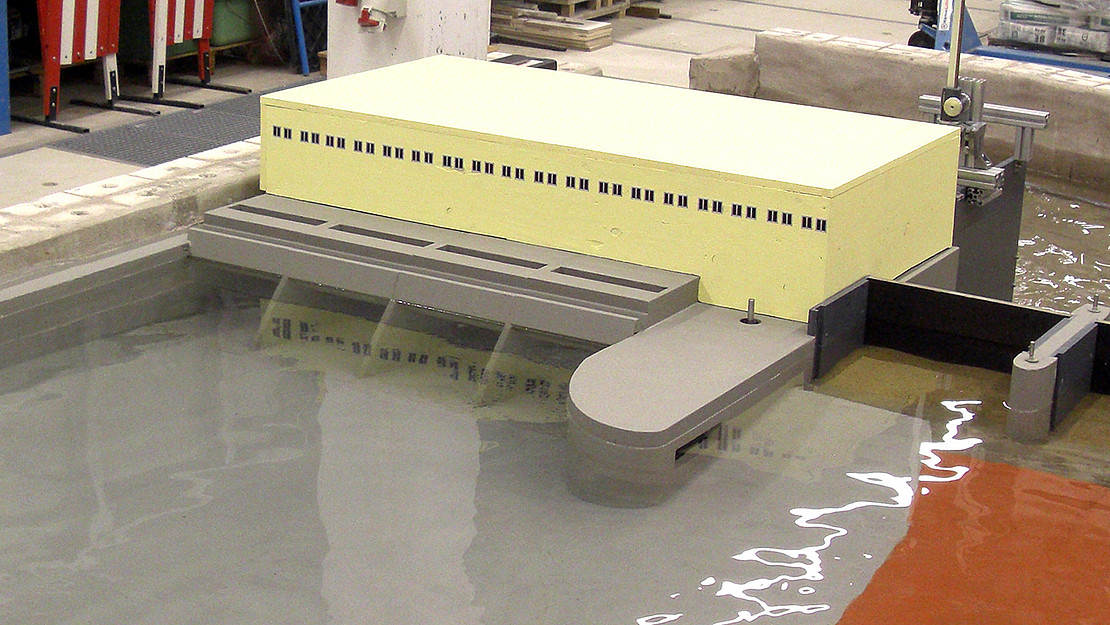This page contains automatically translated content.
Der Rhein im Maßstab 1:50 – Uni Kassel nimmt Modell-Kraftwerk in Betrieb
 Image: University of Kassel, Department of Hydraulic Engineering and Water Resources Management.
Image: University of Kassel, Department of Hydraulic Engineering and Water Resources Management.Das Modell hat eine Grundfläche von rund 100 Quadratmetern, also etwa einer Vierzimmer-Wohnung. Es umfasst ein Modell des Kraftwerks Rheinfelden an der Grenze zur Schweiz sowie der 400 Meter Rhein davor – mit detailgenauem Uferverlauf und genauem Abbild der Fluss-Sohle. Auch das Kraftwerk selber ist mit allen strömungsrelevanten Bauteilen – Turbinen, Krafthaus, Pfeiler u.a. - originalgetreu nachgebaut, so dass eine exakte Simulation der Strömungen nach dem sogenannten Froude-Gesetz möglich ist, einem in der Hydrodynamik wichtigen Grundsatz. Installiert sind verschiedene Messinstrumente und Absperr-Vorrichtungen zur Messung und Regelung von Durchflüssen, zur Erfassung von Wasserständen, Fließgeschwindigkeiten und des Sedimenttransportes. Für die Untersuchungen laufen bis zu 250 Liter Wasser pro Sekunde durch das Modell, was einem Rhein-Abfluss von ca. 4400 Kubikmeter pro Sekunde entspricht.
Mit dem Projektpartner und Betreiber der Kraftwerks Rheinfelden, der Energiedienst Holding AG, untersucht das Kasseler Team um Prof. Dr.-Ing Stephan Theobald Strömungsverhältnisse und simuliert Verbesserungsmöglichkeiten für das Original-Kraftwerk am Rhein, etwa in der Optimierung der Anströmung oder Geschiebeabfuhr. „Die Stärke dieses Modells liegt darin, dass der Durchlauf von realem Wasser die Verhältnisse sehr anschaulich macht und wir so Strömungsverhältnisse sehr genau und zuverlässig abbilden können“, beschreibt Theobald. „Auf dieser Grundlage können wir bauliche und betriebliche Maßnahmen zur energetischen Optimierung ableiten.“ Bis Ende 2017 sollen konkrete Ergebnisse für das Rheinfeldener Werk vorliegen.
Nach Abschluss des Projekts steht dem Fachgebiet das Modell für die Lehre und für Grundlagenforschung zur Verfügung. Die Kasseler Forschungsgruppe beschäftigt sich schwerpunktmäßig mit dem Betrieb von wasserbaulichen Anlagen und dem Zusammenspiel mit strömungsmechanischen Vorgängen in Flüssen und untersucht beispielsweise die Abflussverteilung des zufließenden Wassers durch die Wehrsteuerung von Wasserkraftwerken, die Stauraumbewirtschaftung und ökologische Verbesserungsmaßnahmen. „Neben der Abbildung von Strömungsprozessen bietet das Modell auch die Möglichkeit, Projekt- und Forschungsvorhaben für morphologische Fragestellungen, das heißt der Interaktion zwischen Strömungsvorgang und Sedimenttransport, zu realisieren“, so Theobald. In Kombination mit Naturuntersuchungen dient das physikalische Modell zudem dazu, die numerischen Methoden zu verbessern, um bessere Simulationen zu ermöglichen. Zu diesem Zweck kommen parallel kleinskalige dreidimensionale hydrodynamisch-numerische (3D-HN-) Simulationsverfahren zur Anwendung. Diese Computermodelle ermöglichen dabei ein schnelles, flexibles und kostengünstiges Variantenstudium zur Entwicklung einer Ausführungsvariante, die anschließend im physikalischen Modell abgesichert und weiter verbessert werden kann.
Das alles leistet mittelbar einen wichtigen Beitrag für eine zuverlässige und nachhaltige Energieversorgung in Deutschland, aber auch weltweit. „Die Wasserkraft ist mit einem Anteil von etwa 16,6 Prozent der weltweiten Stromerzeugung mit Abstand die bedeutendste erneuerbare Energiequelle“, so Theobald. „Wenn wir zukünftige Anlagen optimal bauen und zugleich bestehende Anlagen so ausbauen, dass brachliegende Potenziale genutzt werden, können wir den Beitrag der Wasserkraft zu einer nachhaltigen, zuverlässigen und klimaschonenden Energieversorgung noch steigern.“
Fotos:
http://www.uni-kassel.de/uni/fileadmin/datas/uni/presse/anhaenge/2016/Rheinfeld.jpg
Bildunterschrift: Anströmung am physikalischen Modell des Kraftwerks Rheinfelden. Foto: Uni Kassel, Fachgebiet Wasserbau und Wasserwirtschaft.
http://www.uni-kassel.de/uni/fileadmin/datas/uni/presse/anhaenge/2016/Rheinfeld2.JPG
Bildunterschrift: Physikalisches Modell des Kraftwerks Rheinfelden von vorne. Foto: Uni Kassel
Video-Eindrücke unter:
https://www.youtube.com/watch?v=-ebdibqGDmY
Kontakt:
Prof. Dr. Stephan Theobald
Universität Kassel
Fachgebiet Wasserbau und Wasserwirtschaft
Bevorzugt per E-Mail: s.theobald[at]uni-kassel[dot]de
Tel.: +49 561 804-2679